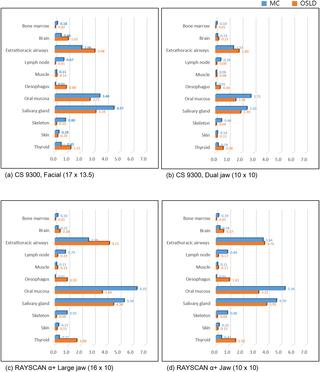Our official English website, www.x-mol.net, welcomes your
feedback! (Note: you will need to create a separate account there.)
Dose assessment in dental cone-beam computed tomography: Comparison of optically stimulated luminescence dosimetry with Monte Carlo method.
PLOS ONE ( IF 2.9 ) Pub Date : 2020-03-31 , DOI: 10.1371/journal.pone.0219103 Chena Lee 1 , Jeongmin Yoon 2, 3 , Sang-Sun Han 1 , Ji Yeon Na 1 , Jeong-Hee Lee 1 , Young Hyun Kim 1 , Jae Joon Hwang 4
PLOS ONE ( IF 2.9 ) Pub Date : 2020-03-31 , DOI: 10.1371/journal.pone.0219103 Chena Lee 1 , Jeongmin Yoon 2, 3 , Sang-Sun Han 1 , Ji Yeon Na 1 , Jeong-Hee Lee 1 , Young Hyun Kim 1 , Jae Joon Hwang 4
Affiliation

|
The variety of cone-beam computed tomography (CBCT) machines and their applications has rapidly increased in recent years, making the dose evaluation of individual devices an important issue. Patient doses from CBCT were assessed with two different methods: optically stimulated luminescence dosimeter (OSLD) measurements and Monte Carlo (MC) simulations, in four different examination modes. Based on an analysis of the measurement process and the obtained values, a recommendation is made regarding which method is more practical and efficient for acquiring the effective dose of CBCT. Twenty-two OSLDs were calibrated and equipped in human phantoms of head and neck organs. They were exposed to radiation from two CBCT units-CS9300 (Carestream Dental LLC, Atlanta, Georgia) and RAYSCAN α+ (Ray Co. Ltd, Hwaseong-si, Korea)-using two different examination modes. The dose recorded using the OSLDs was used to calculate the organ dose and the effective dose for each unit in each examination mode. These values were also calculated using MC software, PCXMC (STUK, Helsinki, Finland). The organ doses and effective doses obtained using both methods were compared for each examination mode of the individual units. The OSLD-measured effective dose value was higher than that obtained using the MC method for each examination mode, except the dual jaw mode of CS9300. The percent difference of the effective dose between the two methods ranged from 4.0% to 14.3%. The dose difference between the methods decreased as the field of view became smaller. The organ dose values varied according to the method, although the overall trend was similar for both methods. The organs showing high doses were mostly consistent for both methods. In this study, the effective dose obtained by OSLD measurements and MC simulations were compared, and both methods were described in detail. As a relatively efficient and easy-to-perform method, we cautiously suggest using MC simulations for dose evaluations in the future.
中文翻译:

牙锥束计算机断层扫描中的剂量评估:蒙特卡罗方法与光学激发发光剂量法的比较。
近年来,锥束计算机断层扫描(CBCT)机器及其应用的种类迅速增加,这使得单个设备的剂量评估成为一个重要的问题。来自CBCT的患者剂量通过两种不同的方法进行评估:光学刺激发光剂量计(OSLD)测量和蒙特卡洛(MC)模拟,采用四种不同的检查模式。基于对测量过程和获得的值的分析,就哪种方法更有效,更有效地获取CBCT剂量提出了建议。校准了22个OSLD,并将其安装在人头颈部器官的幻像中。他们受到了两个CBCT装置的辐射-CS9300(乔治亚州亚特兰大的Carestream Dental LLC)和RAYSCANα+(华城的Ray Co. Ltd,韩国)-使用两种不同的考试模式。使用OSLD记录的剂量用于计算每种检查模式下每个单位的器官剂量和有效剂量。还使用MC软件PCXMC(STUK,赫尔辛基,芬兰)计算了这些值。比较两种方法获得的器官剂量和有效剂量,以每种单位的每种检查模式进行比较。除CS9300的双钳口模式外,每种检查模式下OSLD测得的有效剂量值均高于使用MC方法获得的有效剂量值。两种方法之间有效剂量的百分比差异为4.0%至14.3%。随着视野变小,两种方法之间的剂量差异减小。尽管两种方法的总体趋势相似,但器官剂量值却根据方法而变化。对于这两种方法,显示高剂量的器官大多是一致的。在这项研究中,比较了通过OSLD测量和MC模拟获得的有效剂量,并详细介绍了这两种方法。作为一种相对高效且易于执行的方法,我们谨慎地建议将来使用MC模拟进行剂量评估。
更新日期:2020-03-31
中文翻译:

牙锥束计算机断层扫描中的剂量评估:蒙特卡罗方法与光学激发发光剂量法的比较。
近年来,锥束计算机断层扫描(CBCT)机器及其应用的种类迅速增加,这使得单个设备的剂量评估成为一个重要的问题。来自CBCT的患者剂量通过两种不同的方法进行评估:光学刺激发光剂量计(OSLD)测量和蒙特卡洛(MC)模拟,采用四种不同的检查模式。基于对测量过程和获得的值的分析,就哪种方法更有效,更有效地获取CBCT剂量提出了建议。校准了22个OSLD,并将其安装在人头颈部器官的幻像中。他们受到了两个CBCT装置的辐射-CS9300(乔治亚州亚特兰大的Carestream Dental LLC)和RAYSCANα+(华城的Ray Co. Ltd,韩国)-使用两种不同的考试模式。使用OSLD记录的剂量用于计算每种检查模式下每个单位的器官剂量和有效剂量。还使用MC软件PCXMC(STUK,赫尔辛基,芬兰)计算了这些值。比较两种方法获得的器官剂量和有效剂量,以每种单位的每种检查模式进行比较。除CS9300的双钳口模式外,每种检查模式下OSLD测得的有效剂量值均高于使用MC方法获得的有效剂量值。两种方法之间有效剂量的百分比差异为4.0%至14.3%。随着视野变小,两种方法之间的剂量差异减小。尽管两种方法的总体趋势相似,但器官剂量值却根据方法而变化。对于这两种方法,显示高剂量的器官大多是一致的。在这项研究中,比较了通过OSLD测量和MC模拟获得的有效剂量,并详细介绍了这两种方法。作为一种相对高效且易于执行的方法,我们谨慎地建议将来使用MC模拟进行剂量评估。









































 京公网安备 11010802027423号
京公网安备 11010802027423号